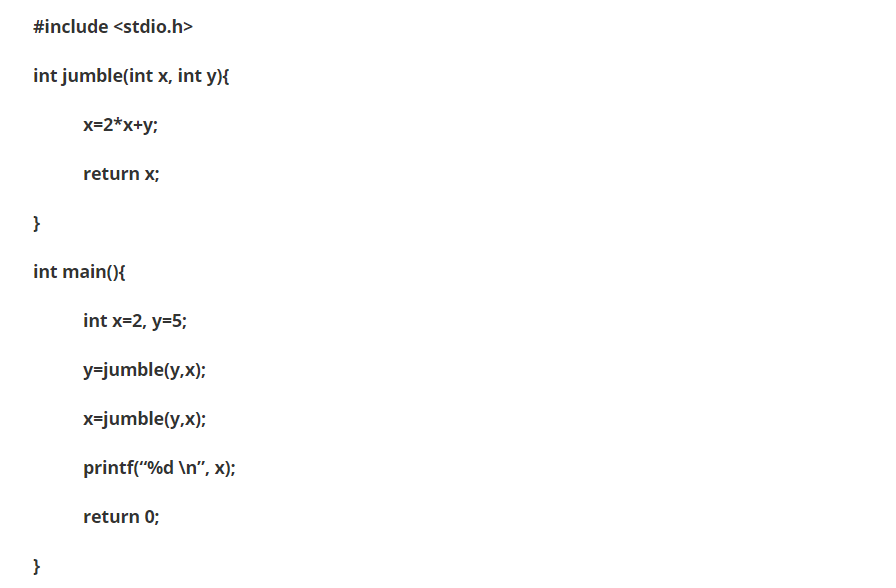QuestionPapersHub.com
GATE-2019

Q: Consider the following C program: The value printed by the program is ________.

GATE-2019
Q: Consider the following C program:
Q: Consider the following C program:
#include
int main(){
int arr[]={1,2,3,4,5,6,7,8,9,0,1,2,5}, *ip=arr+4;
printf(“%d\n”, ip[1]);
return 0;
The number that will be displayed on execution of the program is ___________ .
}
int main(){
int arr[]={1,2,3,4,5,6,7,8,9,0,1,2,5}, *ip=arr+4;
printf(“%d\n”, ip[1]);
return 0;
GATE-2019
Q: Consider the following C function.
Q: Consider the following C function.
void convert(int n){
if(n<0)
printf(“%d”,n);
else {
convert(n/2);
printf(“%d”,n%2);
}
}
Which one of the following will happen when the function convert is called with any positive integer n as argument?
- A: It will print the binary representation of n and terminate
- B: It will print the binary representation of n in the reverse order and terminate
- C: It will print the binary representation of n but will not terminate
- D: It will not print anything and will not terminate
GATE-2019
Q: Consider the following C program:
Q: Consider the following C program:
#include
int r(){
static int num=7;
return num--;
}
int main(){
for (r();r();r())
printf(“%d”,r());
return 0;
}
Which one of the following values will be displayed on execution of the programs?
int r(){
static int num=7;
return num--;
}
int main(){
for (r();r();r())
printf(“%d”,r());
return 0;
}
- A: 41
- B: 52
- C: 63
- D: 630
GATE-2019
Q: Consider the following statements:
Q: Consider the following statements:
I. The smallest element in a max-heap is always at a leaf node
II. The second largest element in a max-heap is always a child of the root node
III. A max-heap can be constructed from a binary search tree in Θ(n) time
IV. A binary search tree can be constructed from a max-heap in Θ(n) time
Which of the above statements are TRUE?
- A: I, II and III
- B: I, II and IV
- C: I, III and IV
- D: II, III and IV
GATE-2019
Q: Let T be a full binary tree with 8 leaves. (A full binary tree has every level full.) Suppose two leaves a and b of T are chosen uniformly and independently at random. The expected value of the distance between a and b in T (i.e., the number of edges in the unique path between a and b) is (rounded off to 2 decimal places) .
GATE-2018
Q: Consider the following C program:
Q: Consider the following C program:
#include
int main(){
float sum = 0.0, j = 1.0, i = 2.0;
while (i/j > 0.0625){
j = j + j;
sum = sum + i/j;
printf("%f\n", sum);
}
return 0;
}
The number of times the variable sum will be printed, when the above program is executed, is _________________.
int main(){
float sum = 0.0, j = 1.0, i = 2.0;
while (i/j > 0.0625){
j = j + j;
sum = sum + i/j;
printf("%f\n", sum);
}
return 0;
}
GATE-2019
Q: Consider the following C program:
Q: Consider the following C program:
#include
int main()
{
int a[ ] = {2, 4, 6, 8, 10};
int i, sum = 0, *b = a + 4;
for (i = 0; i < 5; i++)
sum = sum + (*b – i) – *(b – i);
printf (“%d\n”, sum);
return 0;
}
The output of the above C program is __________.
int main()
{
int a[ ] = {2, 4, 6, 8, 10};
int i, sum = 0, *b = a + 4;
for (i = 0; i < 5; i++)
sum = sum + (*b – i) – *(b – i);
printf (“%d\n”, sum);
return 0;
}
GATE-2018
Q: Consider the following C program.
Q: Consider the following C program.
#include
struct Ournode{
char x,y,z;
};
int main(){
struct Ournode p = {'1', '0', 'a'+2};
struct Ournode *q = &p;
printf ("%c, %c", *((char*)q+1), *((char*)q+2));
return 0;
}
The output of this program is:
struct Ournode{
char x,y,z;
};
int main(){
struct Ournode p = {'1', '0', 'a'+2};
struct Ournode *q = &p;
printf ("%c, %c", *((char*)q+1), *((char*)q+2));
return 0;
}
- A: 0, c
- B: 0, a+2
- C: '0', 'a+2'
- D: '0', 'c'
GATE-2018